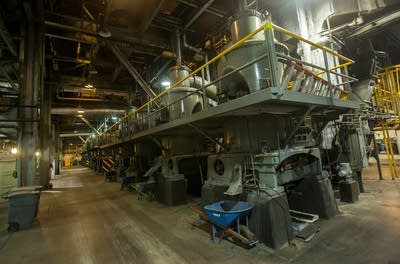Coal power plants under cost, environmental pressure

Inside the Taconite Harbor Energy Center along Lake Superior's North Shore, three turbines the size of train engines crank out 225 megawatts of electricity. That's enough for all of Duluth and Superior, Wis.
The plant has helped power taconite operations since the 1950s. But it also produced unwanted substances. In 2007, Minnesota Power spent nearly $50 million dollars to capture some of the mercury and other pollutants here, Plant Manager Dave Rannetsberger said.
"Now we have a whole new building that was added just for the emission control technologies," he said.
This week a state agency took the unusual step of recommending that five of Minnesota Power's aging coal fired generators in northern Minnesota shut down by 2016, including one of the three turbines at Taconite Harbor.
Create a More Connected Minnesota
MPR News is your trusted resource for the news you need. With your support, MPR News brings accessible, courageous journalism and authentic conversation to everyone - free of paywalls and barriers. Your gift makes a difference.
The Department of Commerce contends it would be cheaper to switch to other sources of electricity — a stance that would have been unheard of just a decade ago. But strict new environmental regulations, combined with cheap natural gas, are forcing utilities and regulators throughout the Midwest to take a new look at their aging coal plants.
The cost of making the plants cleaner is clear at the energy center.
Every day workers make their way along a narrow walkway four stories up, past two huge silos full of lime that is injected into the boilers to help remove sulfur dioxide from the plant's emissions.
Minnesota Power installed pollution controls only on two of the three generating units at Taconite Harbor. Officials say they're waiting to see final EPA regulations before they decide whether to install the expensive equipment on the third generator.
STATE MOVES AHEAD
State officials aren't waiting. They're now siding with some environmental groups, and calling on Minnesota Power to shut down a total of five coal-fired generators at three plants in the next decade.
"It's a very expensive proposition to continue to maintain plants that were built in the 50s and 60s," Minnesota Commerce Commissioner Mike Rothman said.
Rothman and other state commerce officials say closing Minnesota Power's oldest coal generators would save ratepayers as much as $450 million. That's a scenario likely to play out at many coal plants.
"It's maintenance costs and federal clean air requirements that are at play, and the expense just outweighs keeping them in the fleet," Rothman said.
Minnesota Power officials say more analysis is needed. The company's assessment should be ready in the summer of next year, said Al Redeck, vice president for strategy, planning and asset optimization.
"At that time we'll be more poised to maybe make some more decisions about those plants and where we're going," he said.
ADDING GAS TO THE MIX
The Commerce Department and groups like the Minnesota Center for Environmental Advocacy want the Minnesota Public Utilities Commission to force Minnesota Power to move faster. Beth Goodpaster, an attorney for the environmental group, said the utility generates over 90 percent of its electricity from coal.
"Minnesota Power is so heavily dependent on coal in its generation system, and has been for so long, that they have a bigger job to do," she said. "So they should get started earlier, is our opinion."
The utility is planning to cut its coal-based production nearly in half by 2025 by buying hydropower from Manitoba, Canada, and adding wind power. Rudeck, the company vice president, said natural gas will also be in the mix.
"We don't have any gas in our system today, so we think adding some gas is very good to be prudent and more balanced," he said.
That's a move utilities across the country are already making. Xcel Energy has converted two of its coal plants near the Twin Cities to natural gas.
Natural gas plants are a lot more energy efficient and cleaner than coal plants. Technologies such as hydraulic fracturing, or fracking, have helped make natural gas cheaper or more abundant than ever before. Fracking remains highly controversial because some say it damages the environment, but over the past two decades, 80 percent of additions to the power sector have been natural gas plants, Bloomberg Energy analyst Rob Barnett said.
"So already the industry has been choosing natural gas as kind of the default fuel of choice," Barnett said. "And right now, especially where gas prices are, coal is way out of the money."
Even so, most utilities are spending huge sums upgrading their newer and larger coal plants to meet EPA guidelines, rather than shutting them down. Just this week Minnesota Power announced it will spend nearly $400 million on new environmental controls at its Boswell power plant in Cohasset.


